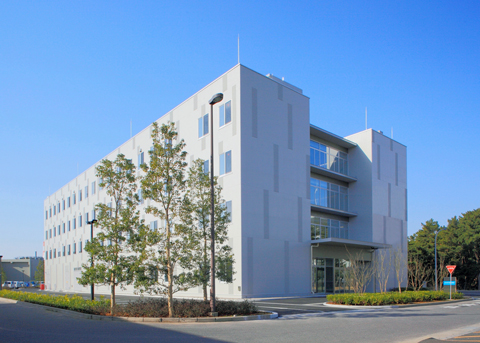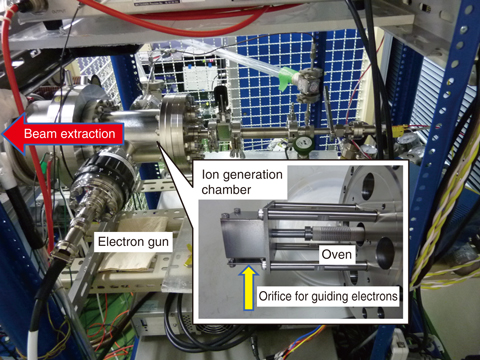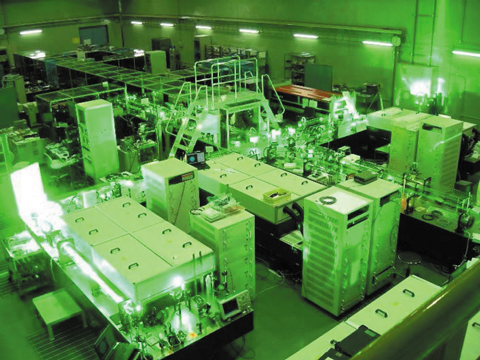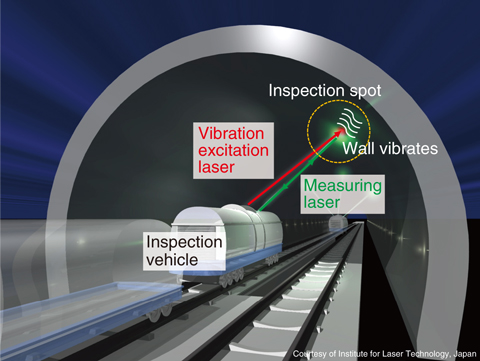
Fig.5-1 Photo of the J-PARC Research Building

Fig.5-2 Test ion source

Fig.5-3 Upgrade of the J-KAREN laser system to J-KAREN-P

Fig.5-4 A defect-detection method using laser beams
In accordance with the “Science and Technology Basic Plan” formulated by the Government of Japan, we are aiming to contribute to the advance of science and technology and the promotion of industry in Japan through the production of innovative results using quantum beams.
In particular, we are making use of various quantum beam facilities, including the high-intensity proton accelerator at the Japan Proton Accelerator Research Complex (J-PARC), the ion-beam irradiation facility known as the Takasaki Ion Accelerators for Advanced Radiation Application (TIARA), the JAEA-Kansai Advanced Relativistic ENgineering (J-KAREN) laser system, and the JAEA synchrotron radiation beamlines at Super Photon ring-8 GeV (SPring-8) for two main purposes, namely, (1) upgrading neutron facilities and devices and utilizing neutron and other quantum beams for nuclear, materials, and life sciences, etc., and (2) developing and advancing the latest technologies for the generation, control, and measurement of quantum beams such as ion beams, light quanta, and the like, and pursuing world-leading research by making comprehensive use of their superior functions.
In this chapter, we will report recent highlights of quantum beam science and technology research in various fields.
1. Upgrade of Neutron Facilities and Devices / Neutron-utilization Research, etc.
J-PARC comprises a series of three proton accelerators, namely, a LINear ACcelerator (LINAC), a 3 GeV Rapid Cycling Synchrotron (RCS), and a 50 GeV synchrotron as well as three experimental facilities. These facilities include the Materials and Life Science Experimental Facility (MLF) for a wide range of research fields using neutron and/or muon beams, the Hadron Experimental Facility for nuclear- and particle-physics experiments using K-mesons and other particles, and the Neutrino Experimental Facility for the T2K particle physics experiment using neutrinos. All these experimental facilities are open to users from across the globe. In FY2015, use of the J-PARC Research Building (Fig.5-1) began, offering opportunities to users to develop experimental devices, prepare samples, and facilitate interaction among users. The accelerators have restarted beam delivery to the Hadron Experimental Facility, which was shut down owing to the radioactive-materials leak accident in May 2013. The user operations of the Hadron Experimental Facility and the Neutrino Experimental Facility were conducted almost as planned throughout the year. On the other hand, the MLF twice experienced the failures in the water shroud of the neutron-production target after the beam intensity was ramped up from 300 kW to 500 kW. Owing to these failures, the beam time allocated to the user programs was diminished. However, both experimental programs and international programs for bringing up future researchers, such as the Asia-Oceania Neutron School, were conducted at 19 neutron instruments and 2 muon beamlines over a wide materials science research field. In this chapter, outcomes from accelerators (Topics 5-1 and 5-2) and from MLF (Topics 5-3 and 5-4) are presented.
Taking advantage of steady-state neutron beams from research reactors such as Japan Research Reactor-3 (JRR-3), we have developed neutron-utilization techniques and applied them to both improving the performance of advanced materials and evaluating the structural reliability of large industrial components based on investigation of the correlation between function and structure. Moreover, we are developing a novel extractant for the separation of minor actinides (MA) and the clarification of the adsorption/desorption reaction mechanisms of radioactive nuclides in soil, thereby contributing to the decommissioning of nuclear-power plants, treatment of radioactive wastes, and improvement of safety (Topics 5-5, 5-6, 5-7, and 5-8).
2. Development of Highly Advanced Quantum Beam Technology / Quantum Beam Science Research
At the Takasaki Advanced Radiation Research Institute, the TIARA, which comprises four ion accelerators, an electron accelerator, and a γ-ray irradiation facilities are available to researchers at JAEA and other organizations for R&D activities related to environmental and energy materials, medical research, and biotechnology. In addition, technological developments currently in progress involve the development of a beam-analysis apparatus for efficient transmission and acceleration of ion beams and techniques for large-area uniform ion irradiation as well as three-dimensional in-air micro-PIXE analysis (Topic 5-9) and microfabrication techniques. FY2015 marked the first year of the development of generation and acceleration techniques for MeV fullerene (C60) ion beams and their applications. We created a conceptual design of an ion source for a Tandem accelerator, capable of generating negative-ion beams of C60 at several hundred nA. We constructed a test ion source on a trial basis (Fig.5-2), with which we have determined the conditions for generating high-intensity negative-ion beams.
In the Kizu District of Kansai Photon Science Institute (KPSI), the most advanced academic research on laser acceleration of electrons and ions, as well as on the industrial and medical applications of lasers, has been conducted using the world’s top class high-peak-power laser technology for innovation. In FY2015, the installation of a final amplifier in the J-KAREN laser system was completed and the system is now called J-KAREN-P (“P” for peta-watt, Fig.5-3); it has been upgraded to generate sufficient energy to obtain a peak power in the PW range at a 0.1 Hz repetition rate (Topic 5-10). Moreover, in the development of high-speed inspection of the soundness of tunnel concrete with lasers, which is financially supported under the cross-ministerial Strategic Innovation Promotion Program (SIP) of the Cabinet Office of the Government of Japan, we have succeeded in accelerating the inspection of defects by 50 fold over conventional methods (Fig.5-4).
In the Harima District of KPSI, the JAEA synchrotron-radiation beamlines at SPring-8 have been utilized to develop a state-of-the-art analytical technique for materials science research. Furthermore, external researchers are being supported as part of the Nanotechnology Platform Project entrusted to us by MEXT. About 28% of all user time was provided for external use in FY 2015.
We are making the most of these quantum beam facilities for the production of radionuclides and the development of structural analysis techniques for biopolymers, and the like for the sake of medical treatment and diagnosis (Topics 5-11 and 5-12). In addition, we are also developing analytical and evaluation methods to clarify the mechanisms of radiation-induced biological actions (Topic 5-13). Through these R&D activities, we expect to contribute to the realization of a healthy and active aging society, the production of biological and regional resources, and the strengthening of the primary industries (namely agriculture, forestry, and fishing), of our nation (Topic 5-14).
In the field of materials science, we are utilizing charged particle beams and radioisotopes to research and develop technologies to create advanced functional materials as well as techniques for controlling and measuring spin information for realization of innovative electronic devices (Topics 5-15 and 5-16). Toward industrial applications, we are also utilizing lasers as well as the laser-driven quantum beams to develop sophisticated techniques for material detection, vibration measurement, microanalysis of radioactive nuclides, and separation of elements (Topics 5-17 and 5-18). Furthermore, using synchrotron radiation and computational science, we are promoting research and development on the analysis and evaluation of the structures, qualities, and functional origins of environmental and energy materials such as hydrogen-storage materials (Topic 5-19).
Other research subjects related to application of quantum beams to recovery from the accident at the TEPCO’s Fukushima Daiichi NPS, are described in Topics 1-13 and 1-14 in Chapter 1.
A part of quantum beam science research was taken over to the National Institutes for Quantum and Radiological Science and Technology (QST) established in April 2016 (reported in section 2 of this article).